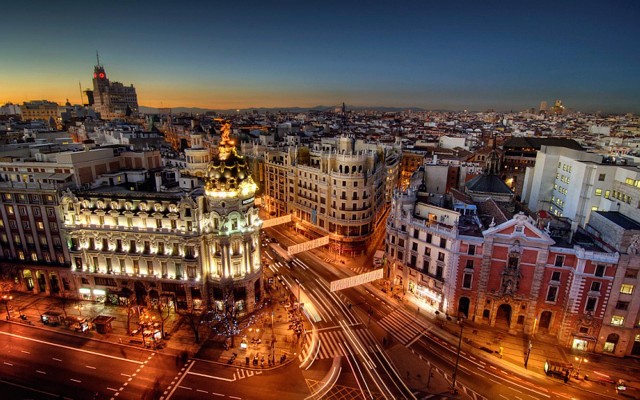Madrid
WITH A POPULATION of 3,092,759 and crossed by the Manzanares River, Madrid is the capital and largest city in SPAIN. Located approximately at the center of the Iberian Peninsula, at the foot of the Sierra de Guadarrama, Madrid has a dry continental climate, with hot summers and cool winters.
After enduring conquest by the Moors in 939 and reconquest by the Christian kings in 1083, Madrid was made the capital only in 1561, becoming the center of the largest world empire of the time. At the beginning of the 17th century, the city lost some of its medieval character (irregular blocks and narrow streets), with the new Plaza Mayor (Main Square) becoming the new center. A great number of churches and convents were built in this period.

Madrid attained a new level of development in the second half of the 18th century, with construction of the Paseo (boulevard) del Prado, the Botanical Garden, and the Puerta de Alcala; elegant palaces were added by the nobility.
By 1750, Madrid had 160,000 inhabitants and its population density increased until 1850 when 280,000 people were living in a cramped city, calling for urban renewal. Response was the tearing down of the city walls in 1857 and the project of the Ensanche (expansion), originating the neighborhoods of Salamanca, Chamberi, and Arguelles to the north and east, known as Plan Castro of 1870. By the end of the century, construction of Arturo Soria's innovative Linear City was initiated to the northeast as an example of liberal urbanism conciliating urban and rural life. Because of its relative isolation, only in the 19th century did Madrid become the largest city in Spain, becoming a place of production.
In 1910, the Gran Via tore through the city to connect the new large neighborhoods. Madrid was bombed during the Spanish Civil War (1936–39), creating an opportunity to better plan a renewed city and to articulate a ring of peripheral settlements and greenbelts. In the 1950s and 1960s, la Castellana was extended to the north and the area became the new financial and commercial center. Because of its growth and importance, in 1984, Madrid became an Autonomous Community.
MODERN MADRID
Madrid is today a large and dynamic cosmopolitan city with world-class museums and three large urban parks: the Parque del Oeste, the central Parque del Buen Retiro, and the huge Casa de Campo forest park with its 4,448 acres (1,800 hectares) sprawling to the west of the royal palace. The city is the seat of the government and of the royal family, but despite the importance of services, Madrid keeps relevant industrial activity, producing automobiles, electrical equipment, farming machinery, chemicals, and other goods. A web of expressways and railroads radiate from the city in almost every direction, crossing residential suburbs and industrial areas to connect the capital to all regions of Spain.